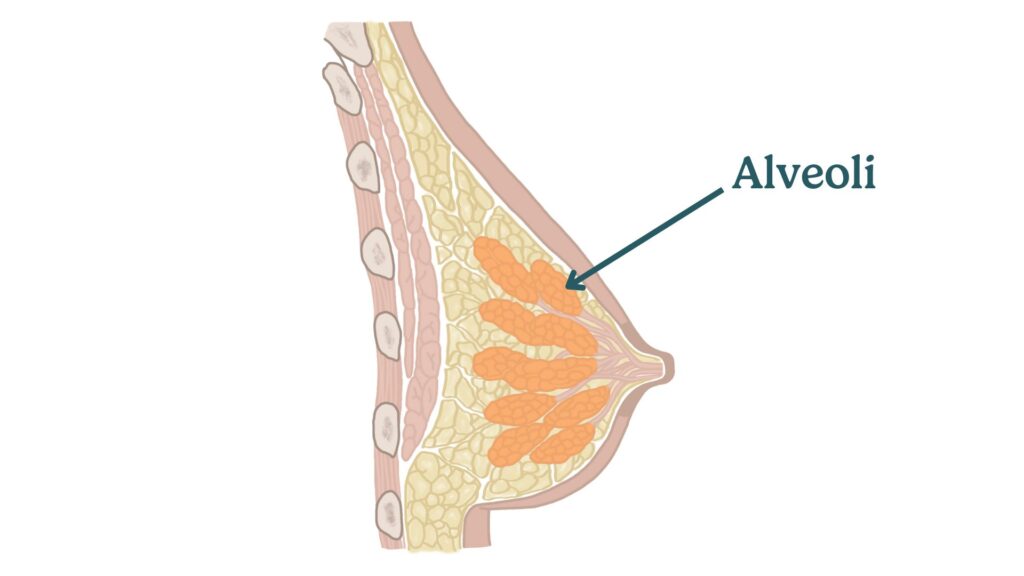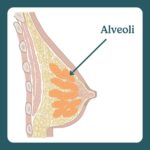breast alveoli

What are breast alveoli?
Breast alveoli are tiny, grape-like clusters of cells located within the breast tissue. These small sacs are crucial for milk production during breastfeeding. When you breastfeed, the hormone prolactin stimulates the alveoli to produce milk. This milk is stored in the alveoli until your baby latches onto your breast and begins to suckle, which triggers the release of another hormone, oxytocin. Oxytocin causes the muscles around the alveoli to contract, pushing the milk into the milk ducts and out through the nipple to your baby.
Warnings
There are a few potential issues related to breast alveoli that new moms should be aware of:
- Engorgement: This occurs when your breasts become overly full of milk, causing them to feel hard and painful. Engorgement can happen if the alveoli produce more milk than your baby consumes. To prevent or relieve engorgement, nurse your baby frequently and ensure they have a proper latch. Engorgement usually lasts a few days to a week. If it persists beyond a week or causes difficulty in latching, consult with a healthcare professional or lactation consultant. Read more about engorgement and how to manage it.
- Blocked milk ducts: When milk becomes trapped in the ducts, it can cause localized pain and a firm lump in your breast. This issue hinders the proper flow of milk from the alveoli to your baby. To resolve this, continue breastfeeding or pumping, gently massage the affected area, and apply warm compresses. Blocked ducts typically resolve within 24-48 hours. If the issue persists beyond 48 hours or shows signs of infection, seek medical advice. Learn more about plugged milk ducts and how to prevent them.
- Mastitis: Mastitis is an infection that causes breast pain, swelling, redness, and flu-like symptoms. It can affect the alveoli, potentially reducing milk production. To help clear the infection, continue breastfeeding and seek medical help promptly, as antibiotics may be required. If you suspect mastitis, don't wait to seek professional help, as early treatment can prevent complications and promote faster recovery. Read more about managing and preventing mastitis.
- Low milk supply: Low milk supply can occur if the alveoli aren't producing enough milk to meet your baby's needs. Encourage milk production by breastfeeding frequently, ensuring a proper latch, and considering the guidance of a lactation consultant. If you're still concerned after a week or two or notice signs of dehydration in your baby, reach out to a healthcare professional or lactation consultant. Learn more about increasing your breastmilk supply.
Physical limitations or health circumstances
Certain physical limitations or health circumstances can affect the normal function of the alveoli:
- Insufficient glandular tissue (IGT): This condition, where the breast tissue does not develop fully during puberty and pregnancy, leads to a reduced number of alveoli and milk-producing capacity. IGT can result in low milk supply, making it challenging to exclusively breastfeed.
- Breast surgery: Surgeries such as breast reduction, augmentation, or mastectomy can impact the alveoli and milk ducts, possibly affecting milk production or the flow of milk through the breast. The extent of the impact depends on the type of surgery and the techniques used. Learn more about breastfeeding after breast surgery.
- Hormonal imbalances: Conditions like polycystic ovary syndrome (PCOS) or thyroid disorders can affect hormone levels, which in turn may influence the function of the alveoli and milk production. Proper management of these conditions can help support successful breastfeeding.
- Diabetes: Mamas with diabetes may experience delayed milk production or a reduced milk supply, as the condition can affect the alveoli's responsiveness to prolactin, the hormone responsible for milk production.
- Previous radiation therapy: If you've undergone radiation therapy to your chest or breast area, the alveoli and surrounding tissue might be affected, potentially leading to reduced milk production or difficulties with breastfeeding.
Other terms
Understanding these related terms can help you better grasp the breastfeeding process and the role of alveoli:
- Prolactin: This hormone stimulates the alveoli to produce milk. Prolactin levels increase during pregnancy and nursing, allowing your body to produce and maintain an adequate milk supply for your baby.
- Oxytocin: Often called the "love hormone," oxytocin is released during breastfeeding. It causes the muscles around the alveoli to contract and release milk, a process known as the let-down reflex. Oxytocin also helps promote bonding between you and your baby.
- Let-down reflex: This process involves the release of milk from the alveoli and its flow through the milk ducts to the nipple. The let-down reflex is triggered by your baby's sucking and the release of oxytocin. Learn more about let-down and how to trigger it.
- Milk ducts: Small tubes that transport milk from the alveoli to the nipple, allowing your baby to feed.
- Lactogenesis: The process of milk production and secretion in the breast. Lactogenesis has three stages: lactogenesis I (hormonal changes during pregnancy), lactogenesis II (initiation of milk production after birth), and lactogenesis III (maintenance of milk production during breastfeeding).
- Colostrum: The first milk your body produces, usually for the first few days after giving birth. Colostrum is thick, yellowish, and rich in antibodies and nutrients, providing crucial immune support and nourishment for your newborn.
- Foremilk and hindmilk: Foremilk is the initial milk that comes out during a feeding, which is thinner and lower in fat content. Hindmilk is the milk that comes later in the feeding, which is thicker and richer in fat, providing essential calories for your baby's growth and development.
Sources: https://www.bfmed.org/assets/ABM%20Protocol%20%2336.pdf


